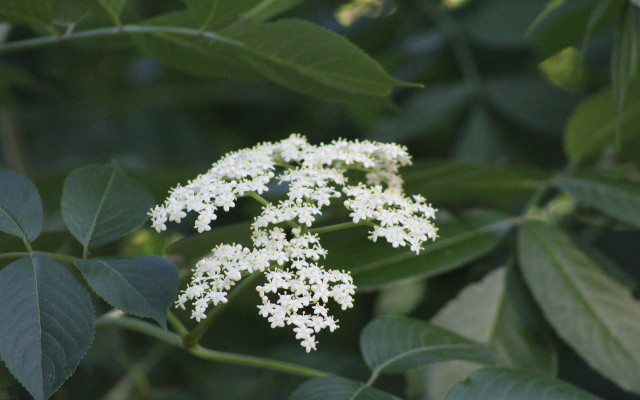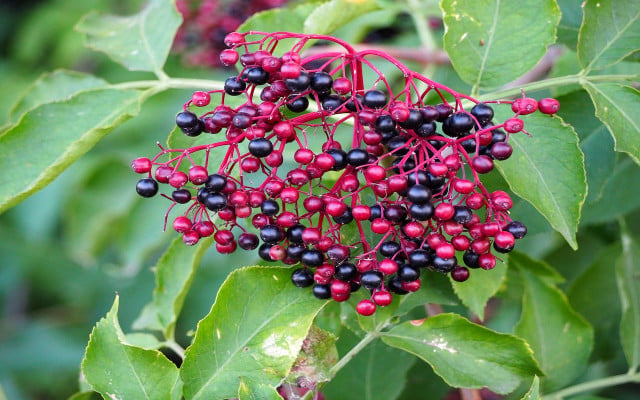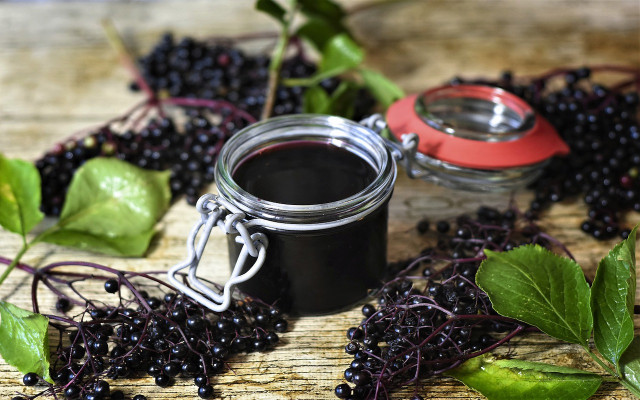Elderberries are small summer fruit with a surprisingly tart flavor. We’ll look at where to find wild elderberries, how to harvest them, and their many uses.
The flowering and fruit-bearing elder (Sambucus) is a shrub with multiple branching systems that can grow to the size of a small tree. There are approximately 200 Sambucus species across the globe, however only four of them are commonly found in North America.
Native Species:
- American Elder (Sambucus canadensis): commonly found in zones 4 through 9 along the East Coast, the Midwest and into Canada.
- Blue Elderberry (Sambucus caerulea): commonly found in zones 4 through 8 and is native to the West Coast. You’ll find it all the way from Oregon down to California and as far east as Texas.
Introduced Species:
- European Elderberry (Sambucus nigra): this species is native to southwestern Asia, north Africa and Europe and thrives in zones 5 through 7.
- Red Elderberry (Sambucus racemose): prefers the cooler temperatures of zones 3 through 7.
For more information about plant hardiness zones, check out the USDA’s map.
What Do Elderberries Look Like?

Elders grow in several different environments across the continent – from roadsides to backyards and on the edge of forests, marshes and rivers. They like full to partial sun and love moist, nitrogen-rich soil.
One way to identify the right bush is by looking for its flowers in spring. Elderflowers bloom as early as March through until July. The cream-colored flowers grow in large clusters and each individual bloom has five petals and a lot of pollen in the middle. You can harvest some of the flowers and make note of the location of the bush so you can come back and harvest the berries.
Birds and wildlife love wild elderberries, so let them guide you to the right plant. If you see a bush that you think fits the bill and there are birds enjoying the berries, chances are you’re on the right track! To make sure you have the right plant, check the leaves. They have serrated edges and grow opposite of one another in a compound of five to eleven leaves.
The berries themselves are the easiest way to identify the elderberry bush. Here’s what elderberries look like:
- Elderberries range in color from dark purple to black and grow in clusters on red stems.
- Blue elderberries are coated in a white yeast when they’re ripe making them easier to distinguish from black elderberries.
- Red elderberries grow in a cone like shape as opposed to the umbrella shape of the other varieties.
Remember: if you’re not sure if you’ve found the right plant, ask a local foraging expert in your region. They’ll be able to help you determine what you’ve found. It’s better to be safe than sorry when foraging.
Harvesting Elderberries: When and How



Depending on where you live, elderberry season can start as early as July and typically goes through til mid September. Many elder bushes are on private property, therefore it is always important to ensure you ask permission before harvesting. Foraging is a privilege, not a right, so it’s best to treat it as such.
To harvest, simply take a pair of pruning shears or sharp scissors and cut the stem at the base of the fruit. The stems and leaves are toxic, so you don’t need to take anything more than the berries. Bugs like to hang out in the berry clusters, so make sure to give each branch a shake before harvesting.
Which Wild Elderberries to Take:
- Choose clusters that are full of plump, deep purple/ black berries.
- To make sure they’re fully ripe, squeeze a berry or two between your fingers: if the juice is dark purple, it’s ready to harvest.
Which to Leave Behind:
- If you see a cluster where some berries are still red or green, do not harvest or eat them as they are mildly toxic. Leave them on the bush to ripen.
- If you squeeze a berry or two from the cluster and the juice is pale and watery, those aren’t ripe yet, even if they are dark purple on the outside.
Remember to take only what you need. Wildlife and other foragers also rely on the tart little berries. If you want to have unlimited access to elderflowers and berries, consider planting a few bushes in your backyard. Tip: they grow better in pairs.
Remedy Against Colds and More Health Benefits
Generally speaking, in order to safely consume elderberries, you need to cook them first. This is because they contain cyanogenic glycoside and alkaloids, and cooking them breaks those down. Other than the berries and the flowers, all other parts of the elder shrub are toxic to humans.
However, there are also many health benefits associated with this tiny berry. They are high in vitamin C and dietary fiber, and studies have found them to be antioxidant and anti-inflammatory. In folk medicine, the elderberry bush is considered to be one of the world’s most healing plants.
Medicine made from elderberries can be taken regularly during the winter months and may prevent cold and flu-like symptoms. The berries have also been thought to aid things like:
- constipation
- joint and muscle pain
- headaches
- stress
- fevers and chills
Using Wild Elderberries



Whether you’ve harvested elderberries from your own backyard, or you’ve gone out on a foraging mission for wild elderberries, the uses of this versatile summer fruit are vast. Just remember that before further processing, you must remove each berry from the stem as the stem is mildly toxic and should not be used. And always cook the berries, never eat them raw.
- Bake with them: wild elderberries make a great addition to pies, cobblers, jams, jellies, chutneys, and muffins.
- Turn the juice into a syrup, or make it into wine.
- Steep mashed berries in vodka for a tincture for colds and digestion issues.
- Use dried elderberries in tea or to infuse honey.
Storing:
- Dry them: take advantage of those hot and sunny summer days and dry the berries outside. Spread them out in a single layer on baking sheets and cover them with food covers (like these ones on Amazon**) to keep the bugs and birds away.
- Freeze the berries whole: spread them out on a cookie sheet and then transfer them to a container once frozen.
- Freeze the juice: cook the berries over low heat and use a potato masher to release the juice. Pass through a fine mesh cheesecloth and freeze in jars for later use as medicine.
For more information about foraging and using elderberries, check out Everything Elderberry by Suzanne Shmurak, available in your local bookstore, or add it to your cart on Amazon**.
Important Information regarding Health-related Topics.
** Links to retailers marked with ** or underlined orange are partially partner links: If you buy here, you actively support Utopia.org, because we will receive a small part of the sales proceeds. More info.Do you like this post?







